Free Autism and ADHD Tests UK: NHS & Online Options (2025 Guide)
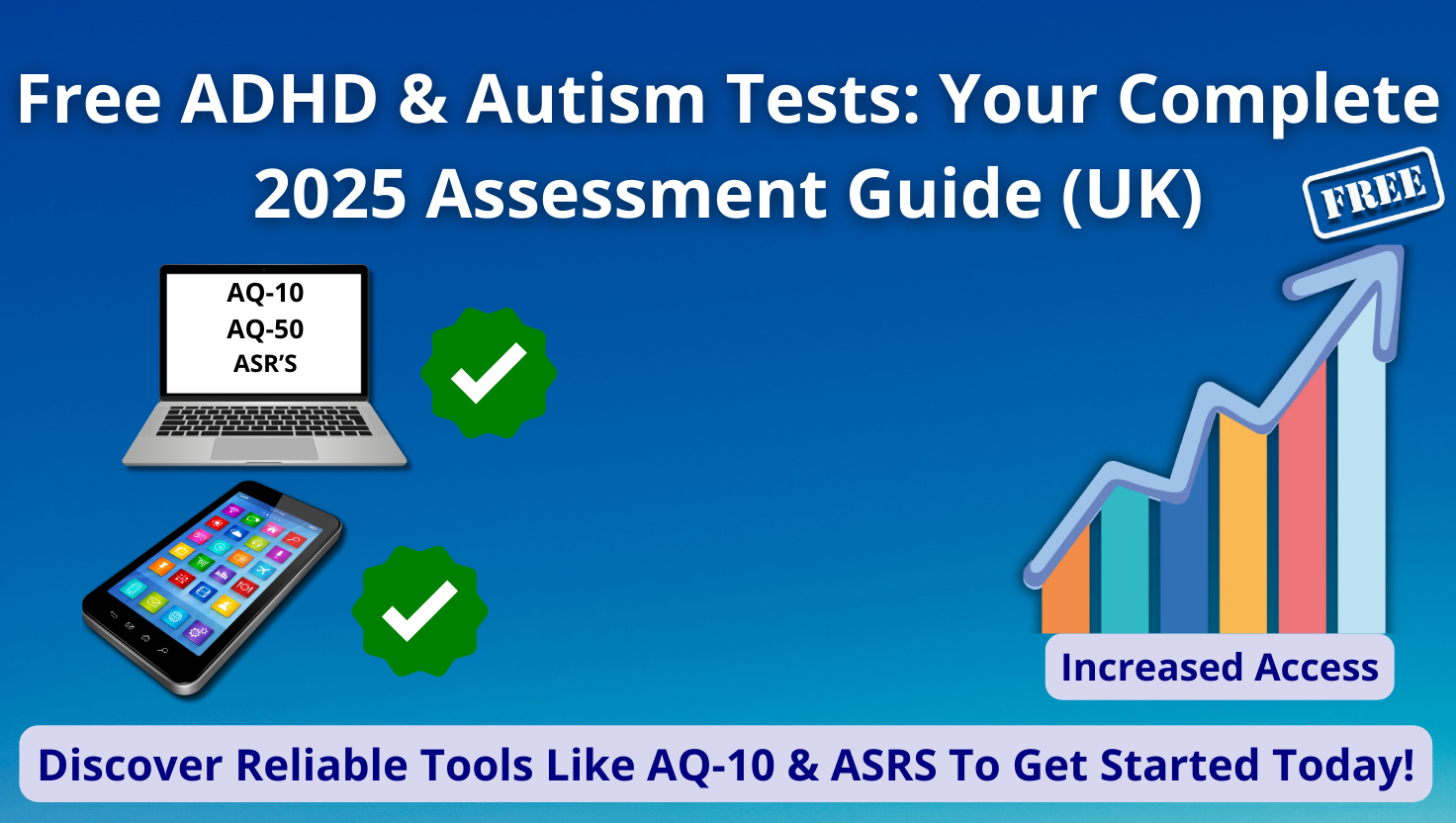
Key Takeaways
While free online autism and ADHD screening tools can provide initial insights, they’re not diagnostic and should be used as a first step only.
The NHS offers free official assessments, but waiting times typically range from 1-4 years.
Online screening tools from reputable organizations like ARC and NHS can help you gather evidence before seeking professional assessment.
For faster access to diagnosis, consider the NHS Right to Choose scheme, which combines NHS funding with private providers to reduce waiting times to around 5.5 months.
Remember that only qualified healthcare professionals can provide official diagnoses, regardless of online test results.
Essential Resources:
- NHS Right to Choose for Faster Assessments – Alternative route for quicker diagnosis
- AQ-10 Adult Test – Cambridge University autism screening tool
- NHS ADHD Self-Assessment – Official NHS screening guide
- RAADS-R Screening – Comprehensive autism screening tool
- National Autistic Society Resources – Support while awaiting assessment
Disclaimer: This guide is for informational purposes only and does not constitute medical advice.
The information provided herein is not intended to be a substitute for professional medical advice, diagnosis, or treatment.
Always seek the advice of qualified healthcare professionals for any questions you may have regarding a medical condition.
Reliance on any information provided in this guide is solely at your own risk.
Introduction: Did you know that waiting times for Autism and ADHD assessments in the UK have increased by 47% since 2023?
Table of Contents
While professional diagnosis is essential, Free Autism and ADHD Tests can help you take that crucial first step in understanding your neurodivergent traits.
What’s fascinating is that 30-50% of individuals with autism also have ADHD, making it important to explore both conditions!
Let’s dive into the most trusted free assessment options available in 2025, helping you make informed decisions about your mental health journey.
How Do Free Autism and ADHD Tests Help You Get Started?
Online tests like the AQ-10 (Autism Spectrum Quotient – 10 Item Version)
and ASRS (Adult ADHD Self-Report Scale) work in a straightforward way to help spot signs of autism and ADHD.
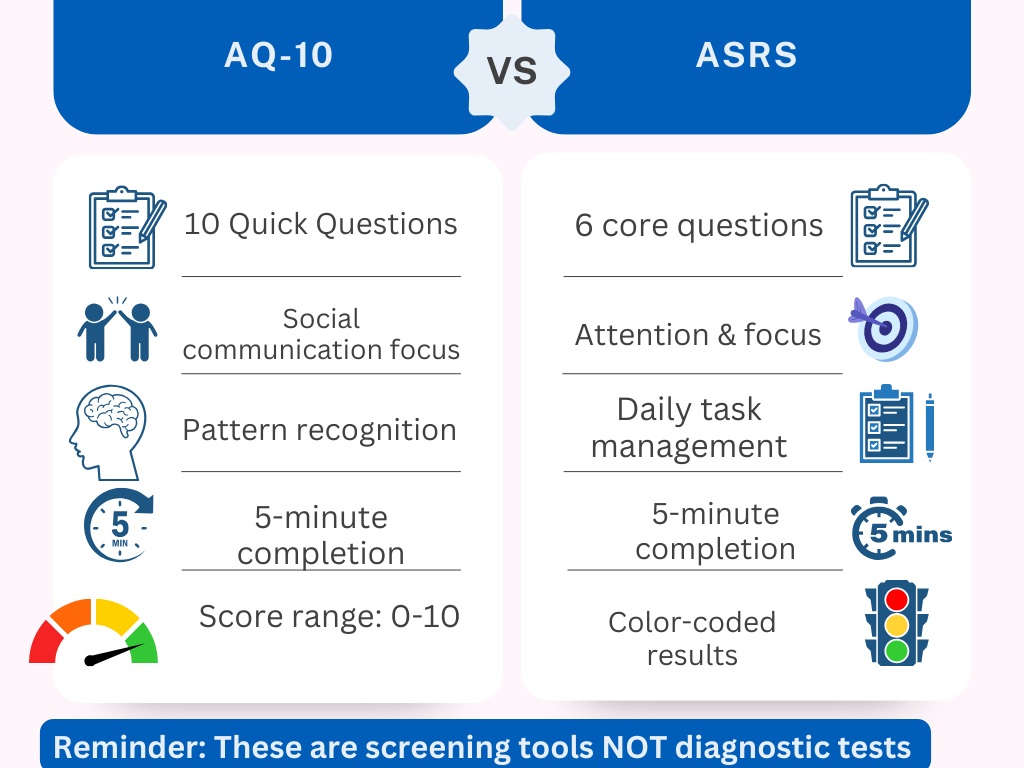
Unlike random internet quizzes, Free Autism and ADHD Tests are proper tools that doctors and researchers have created, using carefully designed questions to check for common traits and experiences.
The AQ-10 test helps look for autism signs by asking specific questions.
It checks things like how you handle social situations and whether you notice small details others might miss.
The ASRS test looks for ADHD signs in a similar way, checking things like how well you can focus and organize tasks.
The National Autistic Society has an excellent pre-assessment guide (https://www.autism.org.uk/advice-and-guidance/topics/diagnosis/pre-assessment/adults) that walks you through what to expect before getting checked for autism.
It’s really worth reading before you try any online tests.
These online tests are a bit like doing a quick health check at home.
They can’t tell you for sure if you have autism or ADHD – only doctors can do that.
But they can help you decide if you should talk to your GP about getting checked out properly.
Why these tests can be helpful:
- They’re free to use
- You can do them any time
- They help you understand yourself better
- You can show the results to your GP
But there are some things to keep in mind:
- Your mood on the day might affect your answers
- Some questions might be hard to understand
- The results aren’t the same as a proper diagnosis
- Everyone has different experiences
The best places to find reliable tests are:
- NHS websites
- University research websites
- Well-known mental health organisations
When choosing reliable Free Autism and ADHD Tests, check that they:
- Come from a trusted health organisation
- Have clear questions
- Give proper results at the end
- Have been tested by researchers
These tests are just the first step. If your results show you might have autism or ADHD traits, the next step is talking to your GP. They can help you get a proper assessment and find the right support.
Remember: these online tests are meant to guide you, not diagnose you.
They’re most helpful when used as part of getting proper help through the NHS or private healthcare.
Free Autism Assessment Resources: Which Tests Can You Trust?
The AQ-10 and full AQ test are the two most used autism screening tools, both developed by experts at the University of Cambridge.

For quick and easy access to these tests, the Autism Research Centre offers them for free on their website (https://www.autismresearchcentre.com/tests/).
Let’s explore how each test works and what they can tell you.
The AQ-10 is the shorter version, perfect if you want a quick initial check.
It takes about 5 minutes to complete and asks just 10 key questions about:
- Social interactions
- Communication patterns
- Attention to detail
- Routines and planning
- Managing change
The full AQ (Autism Quotient) test goes into much more detail. It’s a 50-question assessment that takes about 15-20 minutes. This test:
- Looks deeper into social and communication skills
- Checks how you handle changes and planning
- Explores your attention to detail
- Asks about your imagination and creativity
- Helps spot patterns in how you think and behave
Both tests use a simple scoring system:
- Each question has four possible answers
- You get points based on how strongly you agree or disagree
- Higher scores suggest more autistic traits
- The results can help you decide if you should talk to your GP
For an even more comprehensive assessment, the RAADS-R (Ritvo Autism Asperger Diagnostic Scale-Revised) offers one of the most detailed free screenings available. You can access this in-depth assessment at https://www.autismresearchcentre.com/tests/ritvo-autism-asperger-diagnostic-scale-revised-raads-r/.
This test:
- Takes about 30 minutes
- Has 80 questions
- Looks at how your traits might have changed over time
- Gives a very detailed report
Many autistic people, especially adults and women, develop ways to hide their autistic traits – this is called ‘masking’.
The Camouflaging Autistic Traits Questionnaire (CAT-Q) is specifically designed to identify these hidden traits.
You can take this insightful assessment at https://embraceasd.com/cat-q/.
This test is particularly helpful for people who:
- Feel they might be ‘masking’ their natural behaviours
- Have learned to cope by copying others
- Think they might have gone undiagnosed because they hide their traits
- Want to understand their masking patterns better
Several free apps and online platforms also offer autism screening, but stick to ones from trusted organisations like:
- NHS recommended tools
- National Autistic Society resources
- University research centres
- Established mental health organisations
Want to get the most helpful information?
Try starting with the AQ-10, and if that suggests you might have autistic traits, move on to the full AQ test.
Keep your results and any notes about your experiences – they’ll be really useful if you decide to talk to your GP.
Remember: none of these tools can give you a diagnosis, but they can help you understand yourself better and decide if you’d like to get a professional assessment. It’s always best to be honest with your answers rather than trying to get a particular result.
Reliable Free ADHD Screening Tests: What Are Your Options?
The World Health Organisation’s Adult ADHD Self-Report Scale (ASRS) is a widely trusted free screening tool for ADHD.
Let’s explore this and other options available for initial ADHD screening.
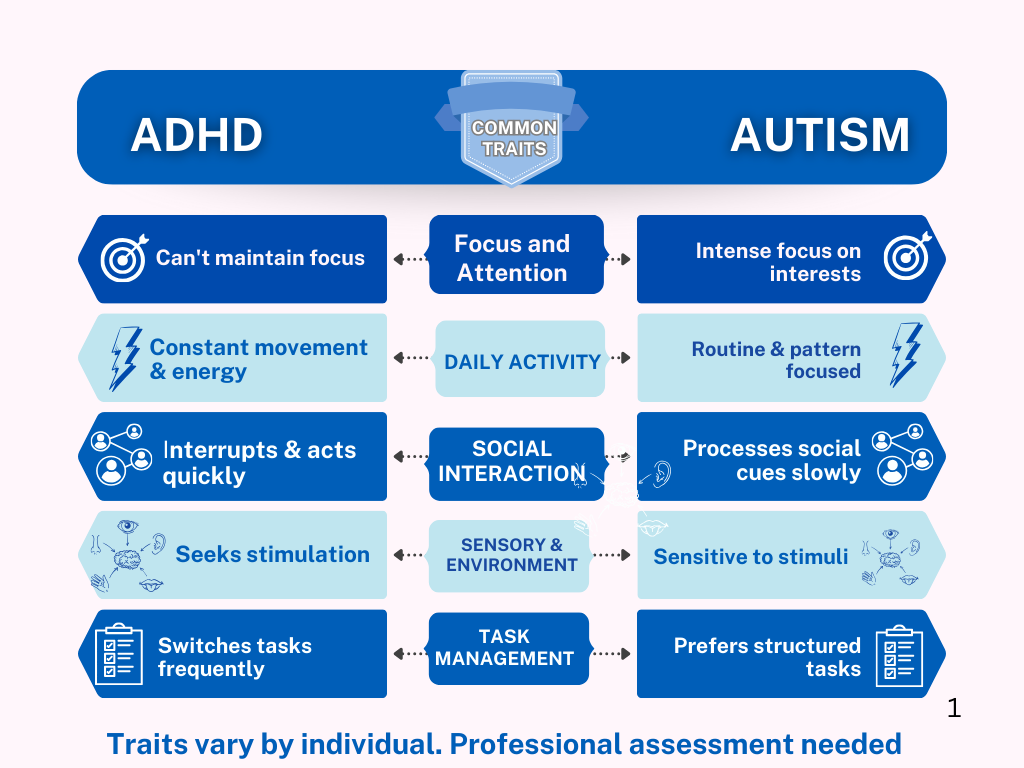
ASRS: A Trusted Starting Point
The ASRS comes in two versions:
1. ASRS v1.1 Screener:
- Quick 5-minute assessment
- 6 key questions on attention and hyperactivity
- Focuses on the past 6 months
- Often used by GPs for initial screening
2. Full ASRS:
- More comprehensive 15-minute test
- 18 questions covering inattentive and hyperactive symptoms
- Provides a detailed picture of potential ADHD traits
For those interested in taking the ASRS, the official WHO version is available here:
https://www.hcp.med.harvard.edu/ncs/asrs.php
What is the ADHD Pathway?
The typical NHS pathway for ADHD assessment often begins with these steps and patients have a right to choose a provider:
If appropriate, the GP will make a referral to an ADHD specialist for a full assessment. Referral is not automatic and depends on individual circumstances.
Complete the ASRS screening test (a free, self-report questionnaire).
Book a GP appointment.
Discuss the test results and your symptoms with your GP.
What are the Best Digital ADHD Screening Tools?
As technology advances, several digital tools have been developed to assist with ADHD screening. When selecting a free online test, it’s important to know what makes a reliable screening tool.
Medical Research Foundation
The most trustworthy digital ADHD screening tools are firmly rooted in medical research. Look for tests that:
Are recognised by healthcare professionals
Follow DSM-5 or ICD-11 diagnostic criteria
Have completed validation studies
Show proven accuracy rates
Cite scientific research clearly
ASRS Integration
The Adult ADHD Self-Report Scale (ASRS) is key to reliable screening:
- Widely respected and validated tool
- Used by healthcare professionals
- Based on WHO research
- Provides consistent results
When choosing a test, check that it:
- Incorporates ASRS questions
- Mentions ASRS in documentation
- Follows ASRS scoring methods
- Uses validated question formats
Clear Results and Interpretation
Quality screening tools should provide:
Easy-to-understand results
Clear explanation of scores
Identified areas of concern
Guidance for next steps
Professional referral advice
Cost Considerations
Look for tools that:
Offer basic screening free
Provide methodology information
Show validation evidence
Give clear cost structures for any advanced options
Recommended Tool
One reputable option is the ADHD Self-Test from Psychology Today, which meets these criteria and is freely accessible.
https://www.psychologytoday.com/us/tests/health/adhd-attention-deficit-disorder-test
Age-Specific ADHD Considerations
It’s crucial to recognise that ADHD presents differently across age groups:
Adults:
- Focus on workplace and relationship impacts
- Examine long-term behaviour patterns
- Consider childhood educational effects
Children:
- Require parent and teacher input
- Need age-appropriate assessments
- Use different scoring criteria than adults
For parents concerned about ADHD in children, the CDC offers a helpful resource:
https://www.cdc.gov/ncbddd/adhd/screening.html
Beyond Screening: Next Steps
While online screening tools provide valuable insights, they’re just the initial step in the ADHD assessment process.
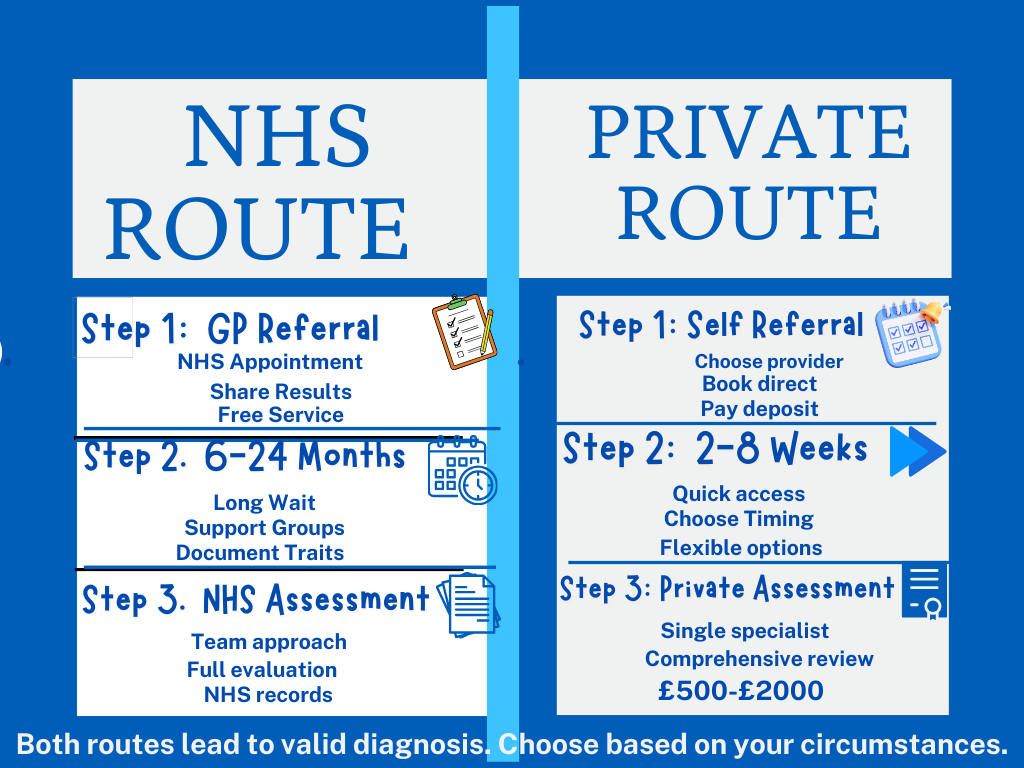
Only qualified healthcare professionals can provide an official ADHD diagnosis.
These screenings help determine if pursuing a professional assessment is warranted.
If you’re ready to take the first step, the NHS recommends starting with the ASRS screening test.
Keep detailed notes about your experiences – this information will be invaluable when discussing your symptoms with healthcare professionals.
Remember, seeking help is a sign of strength.
Understanding Your Free Autism and ADHD Tests Results: What Do They Mean?
After completing these Free Autism or ADHD Tests, understanding your results is crucial for the next steps.
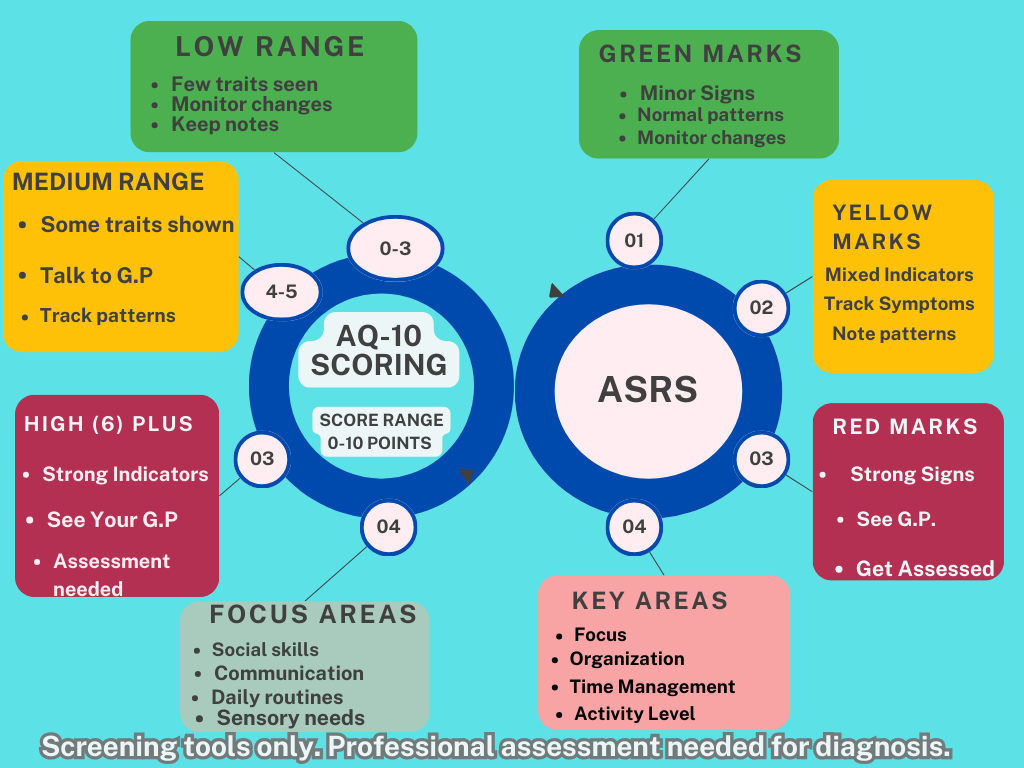
Let’s break down what these neurodivergent traits assessment scores tell you.
Autism Screening Scores:
- AQ-10 autism quotient test: Scores of 6+ suggest seeking professional input
- Full autism screening questionnaire: Scores above 32 indicate significant traits
- Autism behaviour checklist: Look for patterns across different areas
- Autism diagnostic tools: Higher scores mean stronger trait indicators
ADHD Evaluation Results:
- ASRS ADHD screening: Red-marked answers need attention
- ADHD symptom tracker: Note which behaviours occur most frequently
- ADHD diagnostic criteria: Check how many symptoms you experience regularly
- ADHD evaluation tools: Higher scores suggest stronger traits
Common Patterns in Combined Testing:
Free developmental disorder tests often show overlapping traits:
- Difficulty with social communication (autism spectrum indicators)
- Problems with organisation (ADHD self-report scale)
- Sensory sensitivities (neurodevelopmental screening)
- Executive function challenges (neurocognitive screening)
Red Flags for Professional Assessment:
- High scores on multiple free psychological evaluation tools
- Significant impact on daily functioning
- Persistent workplace or educational challenges
- Strong identification with diagnostic descriptions
- Multiple indicators across different online psychological testing platforms
Next Steps After Testing:
1. Save your developmental assessment tools results
2. Document daily experiences
3. Consider NHS autism assessment options
4. Explore ADHD online test UK pathways
Professional Assessment Pathways:
NHS Route:
- Begin with a GP referral, sharing your autism indicators checklist
- NHS waiting times for autism and ADHD assessments can vary significantly depending on your location and the demand for services. While some individuals may experience waiting times of 6 months to 2 years or longer, others may be seen more quickly. We encourage you to check with your local Clinical Commissioning Group (CCG) or GP for the most up-to-date information in your area.
Alternative NHS-Approved Providers Through Right to Choose
The typical NHS pathway for an autism assessment begins with a GP referral. However, waiting times can range from 6 months to 2 years, depending on your location.
Fortunately, if you’re in England, you may be eligible for the Right to Choose scheme, which allows you to request an autism assessment from alternative NHS-approved providers—often reducing wait times significantly.
Understanding your rights can make a huge difference in accessing timely care. Learn more about how to use the Right to Choose option for autism assessments
Private Assessment Options:
- Autism diagnostic tools assessment: £500-£2,000
- ADHD behaviour checklist evaluation: £500-£1,500
- Faster access to neurodevelopmental screening
- Choice of online or in-person assessment
Required Documentation:
- All free mental health screening results
- School/work performance records
- Daily impact examples
- Childhood behaviour evidence
- Completed ADHD evaluation criteria forms
- Autism traits questionnaire responses
Support While Waiting:
- Access free cognitive screening resources
- Join support groups
- Use online neurodevelopmental assessment tools
- Connect with others awaiting diagnosis
- Practice recommended coping strategies
- Continue documenting experiences
Remember:
While online tests provide valuable insights, they’re just the first step.
Professional assessment through either NHS or private routes will provide the comprehensive evaluation for formal diagnosis and support planning.
Limitations of This Guide and Online Screening Tools
It’s important to be aware of the limitations of this guide and the online screening tools discussed:
- The online screening tools are not a substitute for a comprehensive evaluation by qualified healthcare professionals. They provide an initial indication of potential traits but cannot provide a diagnosis.
- The screening tools rely on self-report, which can be subjective and influenced by factors like mood, memory and personal biases.
Results may not always accurately reflect an individual’s actual traits or experiences.
- Cultural and linguistic factors can influence the expression and interpretation of autism and ADHD traits.
The tools may not be equally valid or reliable across all cultural groups.
- The online screening tools are generally designed for adults and may not be appropriate for young children. Parents should consult with pediatricians or child psychologists for age-appropriate assessments.
- These tools are typically not designed or validated for individuals with significant intellectual disabilities or other complex developmental conditions. Specialized assessments may be necessary for these populations.
- Online results should not be used in isolation to make important life decisions. Always consult with healthcare professionals for personalized guidance and support.
Frequently Asked Questions About Autism and ADHD
Before exploring Free Autism and ADHD Tests, it’s important to understand that these conditions often occur together.
Research shows that 50 to 70% of individuals with autism spectrum disorder (ASD) also present with attention deficit hyperactivity disorder (ADHD).
Q: What do ADHD and autism look like together?
A: While Free Autism and ADHD Tests can help identify initial traits, the combination typically shows as:
- Difficulty with social interactions, but for different reasons
- Problems with focus, ranging from inability to focus to intense focus on specific interests
- Sensory sensitivities
- Challenges with organisation
- Trouble with changes in routine
- Some people may experience more significant challenges with brain functions affecting attention and social understanding.
Q: What are the signs of ADHD and autism together?
A: Common indicators that Free Autism and ADHD Tests might help identify include:
- Social communication challenges
- Difficulty reading social cues
- Problems with attention regulation
- Strong need for routine but trouble maintaining one
- Sensory sensitivities
- Executive function difficulties
Remember that these signs can vary significantly between individuals.
Q: How do I know if I’m slightly autistic?
A: While initial screening with Free Autism and ADHD Tests can provide insights, common autism traits include:
- Finding social situations challenging
- Having intense interests in specific topics
- Noticing patterns others might miss
- Being sensitive to sensory experiences
- Preferring routine and structure
Only qualified healthcare professionals can provide a diagnosis.
Q: Can you get tested for ADHD and autism at the same time?
A: Yes, many specialist services offer combined assessments. While Free Autism and ADHD Tests can provide initial insights, professional options include:
- NHS combined assessments
- Private specialist evaluations
- Comprehensive diagnostic services
This approach is particularly valuable given how often these conditions occur together.
Q: Do I have autism or ADHD?
A: While Free Autism and ADHD Tests can provide helpful initial insights, only healthcare professionals can diagnose these conditions. Steps to take include:
1. Complete validated screening tests
2. Document your experiences
3. Discuss results with your GP
4. Seek professional assessment
5. Consider both NHS and private options
It’s important to note that while free online tests can provide initial insights, they are not substitutes for professional evaluation
Conclusion:
While Free Autism and ADHD Tests can provide valuable insights into your neurodivergent traits, they’re just the beginning of your journey.
Remember – these tools are stepping stones, not final diagnoses!
Whether your results suggest further investigation or not, you’re taking a positive step towards understanding yourself better.
While this guide mentions several screening tools, it’s important to consider their validation and reliability.
Not all Free Autism and ADHD Tests are created equal, and some may have limited scientific support.
Look for tools that have been developed and validated by reputable organizations or researchers.
Ready to explore Free Autism and ADHD Tests? Start with these validated tools
Choose one of the validated screening tools above, and don’t hesitate to share the results with your GP.
Your path to understanding your neurodivergent identity starts here!
Throughout this guide, we strive to provide accurate and evidence-based information. Where possible, we have included links to relevant sources and research.
We encourage you to consult these sources for further information and to verify the accuracy of the content.
About the Authors: Dwayne and Charlene are committed to providing accessible and reliable information to families with special needs. Charlene’s extensive experience working with children of all abilities as a professional childminder combines with Dwayne’s personal journey as a father to their son with autism to provide families with a deep understanding of the issues families face. Together, they offer practical guidance and support.




